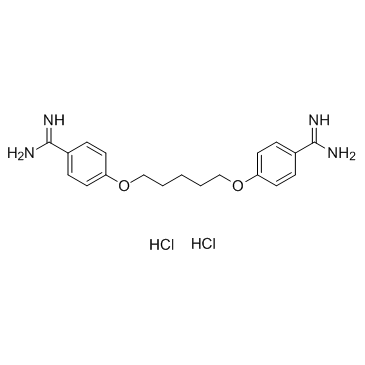Pentamidine dihydrochloride
Modify Date: 2024-01-02 19:54:07

Pentamidine dihydrochloride structure
|
Common Name | Pentamidine dihydrochloride | ||
|---|---|---|---|---|
| CAS Number | 50357-45-4 | Molecular Weight | 413.34 | |
| Density | N/A | Boiling Point | N/A | |
| Molecular Formula | C19H26Cl2N4O2 | Melting Point | N/A | |
| MSDS | N/A | Flash Point | N/A | |
Use of Pentamidine dihydrochloridePentamidine Dihydrochloride(MP601205 dihydrochloride) is an antimicrobial agent.Target: AntiparasiticPentamidine Dihydrochloride has a potent in vitro antiprotozoal activity. Pentamidine displays cytotoxic activity against L. infantum promastigotes with IC50 of 2.5 μM. 2.5 μM Pentamidine induces early programmed cell death in 49.6% of L. infantum promastigotes. 2.5 μM Pentamidine induces a notorious decrease in promastigotes in both G1 and S phases relative to the control-untreated samples (G1:77.0 vs 15.0%; S:11.0 vs 2.4% for control- and pentamidine-treated promastigotes, resp). Pentamidine is able to bind with calf-thymus DNA (CT-DNA) and induces conformational changes in the DNA double helix. Pentamidine also binds with ubiquitin to modifiy the β-cluster of ubiquitin [1]. Pentamidine is an inhibitor of phosphatase of regenerating liver (PRLs). 1 μg/mL of Pentamidine complete inhibits the activity of recombinant PTP1B in dephosphorylating a phos-photyrosine peptide. 10 μg/mL of Pentamidine completely inhibits the activities of recombinant PRL-1, PRL-2 and PRL-3 in dephosphorylating a phosphotyrosine peptide substrate. Incubation with Pentamidine (1 μg/mL) for 48 h reduces the activity of intracellular PRL phosphatases in transfected NIH3T3 cells by more than 85%. 10 μg/mL Pentamidine completely inhibits the growth of melanoma cell line (WM9), prostate carcinoma cell line (DU145 and C4-2), ovarian carcinoma cell line (Hey), colon carcinoma cell line (WM480), and lung carcinoma cell line (A549) which all express endogenous PRLs [2]. |
| Name | Benzenecarboximidamide, 4,4'-[1,5-pentanediylbis(oxy)]bis-, dihydrochloride (9CI) |
|---|---|
| Synonym | More Synonyms |
| Description | Pentamidine Dihydrochloride(MP601205 dihydrochloride) is an antimicrobial agent.Target: AntiparasiticPentamidine Dihydrochloride has a potent in vitro antiprotozoal activity. Pentamidine displays cytotoxic activity against L. infantum promastigotes with IC50 of 2.5 μM. 2.5 μM Pentamidine induces early programmed cell death in 49.6% of L. infantum promastigotes. 2.5 μM Pentamidine induces a notorious decrease in promastigotes in both G1 and S phases relative to the control-untreated samples (G1:77.0 vs 15.0%; S:11.0 vs 2.4% for control- and pentamidine-treated promastigotes, resp). Pentamidine is able to bind with calf-thymus DNA (CT-DNA) and induces conformational changes in the DNA double helix. Pentamidine also binds with ubiquitin to modifiy the β-cluster of ubiquitin [1]. Pentamidine is an inhibitor of phosphatase of regenerating liver (PRLs). 1 μg/mL of Pentamidine complete inhibits the activity of recombinant PTP1B in dephosphorylating a phos-photyrosine peptide. 10 μg/mL of Pentamidine completely inhibits the activities of recombinant PRL-1, PRL-2 and PRL-3 in dephosphorylating a phosphotyrosine peptide substrate. Incubation with Pentamidine (1 μg/mL) for 48 h reduces the activity of intracellular PRL phosphatases in transfected NIH3T3 cells by more than 85%. 10 μg/mL Pentamidine completely inhibits the growth of melanoma cell line (WM9), prostate carcinoma cell line (DU145 and C4-2), ovarian carcinoma cell line (Hey), colon carcinoma cell line (WM480), and lung carcinoma cell line (A549) which all express endogenous PRLs [2]. |
|---|---|
| Related Catalog | |
| References |
| Molecular Formula | C19H26Cl2N4O2 |
|---|---|
| Molecular Weight | 413.34 |
| PSA | 118.20000 |
| LogP | 5.28490 |
| Storage condition | 2-8℃ |
| Pentamidine |
| Pentamidine dihydrochloride |
| Pentamidine (dihydrochloride) |